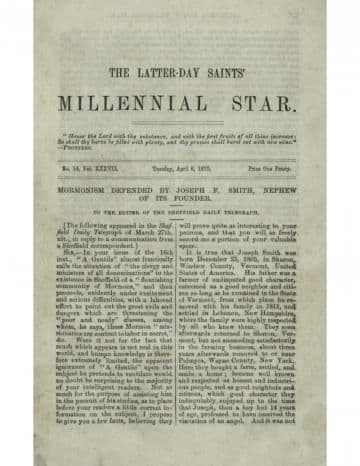Magazine
Old America: Jared

Title
Old America: Jared
Magazine
The Latter Day Saints' Millennial Star
Publication Type
Magazine Article
Year of Publication
1875
Authors
O., G. M. (Primary)
Pagination
212–213
Date Published
6 April 1875
Volume
37
Issue Number
14
Abstract
This series gives a brief synopsis of Jaredite history including their sailing to the American continent from the Tower of Babel. It also cites many ancient American flood myths that relate to the biblical story of the flood at the time of Noah. The second part describes various Native American traditions.
OLD AMERICA.
JARED.
[Continued from page 199.]
The Zapotekas, of South America, boast of being antediluvian in America, and to have built the city of Coatlan, so called because it was founded at a place which swarmed with serpents, Coat-lan meaning snake-city. It was built, according to their tradition, three hundred and twenty-seven years before the flood. At the time of the flood a remnant of their people, together with their king, named Petela, saved themselves on a mountain.
The Aztec tradition, in fact, their laws and religion, were received from the Toltecs, whom they supplanted. They begin by telling us that Noah, whom they call Tezpi, saved himself and his wife, whom they call Xochi-quetzal, on a raft or canoe. The raft or canoe rested at the foot of a mountain called Colhuacan after the flood. They say that on this raft, besides Tezpi and his wife, there were several children and animals, with grain, the preservation of which was of great importance to mankind. When the Great Spirit, Tezcatipoca, ordered the waters to withdraw, Tezpi sent from his raft a vulture, which never returned, on account, of the great number of dead carcasses found to feed upon. He then sent other birds, one of which was a humming-bird, which alone returned, holding in its beak a branch covered with leaves. Tezpi, seeing that fresh verdure covered the earth, quitted the raft near the mountain. They say that the men born after this deluge were born dumb, but a dove distributed the languages to them.
Professor Schoolcraft, in his elaborate report to the Smithsonian Institute, and Catlin, in his history of the North American Indians, describe a very interesting ceremony, commemorative of the deluge and releasing of the birds, as annually performed by the Mandans, a nation now extinct, but who formerly inhabited the country between the Little Missouri and Yellowstone rivers. They are described as being, of a much fairer complexion than the Indians of other nations, it being no unusual thing to find persons with blue eyes and fine reddish-colored hair among them. They were domestic in their habits, resided in villages and engaged in agricultural pursuits. Among the painted pictures or books made of animals’ skins (parchment) and of leaves (the aloe), examined by Humboldt were not only delineated pictures of the deluge, but of all the leading circumstances in the history of the fall of man, and of the seduction of the woman by means of the serpent; also of the first murder, perpetrated by Cain on the person of his brother Abel.
These traditions and paintings go far to prove the truthfulness of the book of Genesis, and sustain and verify the record of Ether. It is a link that connects them with Asia and their ancestor Noah, and all the circumstances connected with the stranding of the ark on Ararat, and the confounding and separation at Babel.
Here, for some fifteen hundred years, the Jaredites flourished and grew into a great nation, building cities, cultivating the land and drifting into wickedness, until they were destroyed by the Lord, some six hundred years before Christ. Their historian lived to see and record this destruction, and his records were found by a colony of Israelites who came from Jerusalem, about that time under the leadership of Nephi. This colony grew and multiplied into two mighty nations, called the Nephites and Lamanites. The latter nation, falling into idolatry, was cursed by God, and became dark and benighted. The American Indians are the descendants of this nation. The Nephites remained a civilized and enlightened nation, and had many blessings and privileges conferred upon them, but falling into wickedness in their turn, during the third and fourth century of the Christian era, they were finally destroyed by the Lamanites about A.D. 385. The history of these two nations is found systematically recorded in the Book of Mormon, only, and it is impossible to separate the mass of secular evidence of the enlightenment and high cultivation of those ancient people that I shall give, or definitely ascribe a tradition, a record or a ruin to the people of Jared, or to the people of Nephi. The Jaredites undoubtedly left records, and Monuments, and cities scattered over the land. These same cities were reoccupied by the Nephites, and their records and traditions were amalgamated. The Nephites in turn were destroyed, and the uncivilized Lamanite had so entangled and interwoven and lost the connecting links of the several and distinct histories of the two great nations they supplanted, and so confounded and mixed the records with their own traditions by the time of the European occupancy, that it is beyond the power of man to fix data or determine as to what portion is of Jaredite and what of Nephite origin.
Herrera, a Spanish historian of the sixteenth century, in his history of America, (vol. 4 page 172), says, “Baptism was known in Yucatan; the name they gave it signified to be born again.” Here is a ceremony undoubtedly of Nephite origin.
—Juvenile instructor.
(To be continued.)
Subject Keywords
Bibliographic Citation
Terms of use
Items in the BMC Archive are made publicly available for non-commercial, private use. Inclusion within the BMC Archive does not imply endorsement. Items do not represent the official views of The Church of Jesus Christ of Latter-day Saints or of Book of Mormon Central.